
They'll Do It Every Time is a single-panel newspaper comic strip, created by Jimmy Hatlo, which had a long run over eight decades, first appearing on February 5, 1929, and continuing until February 3, 2008. The title of the strip became a popular catchphrase.

A topper in comic strip parlance is a small secondary strip seen along with a larger Sunday strip. In the 1920s and 1930s, leading cartoonists were given full pages in the Sunday comics sections, allowing them to add smaller strips and single-panel cartoons to their page.

Boob McNutt was a comic strip by Rube Goldberg which ran from June 9, 1918 to September 23, 1934. It was syndicated by the McNaught Syndicate from 1922 until the end of its run.
United Feature Syndicate, Inc. (UFS) is a large American editorial column and comic strip newspaper syndication service based in the United States and established in 1919. Originally part of E. W. Scripps Company, it was part of United Media from 1978 to 2011, and is now a division of Andrews McMeel Syndication. United Features has syndicated many notable comic strips, including Peanuts, Garfield, Li'l Abner, Dilbert, Nancy, and Marmaduke.
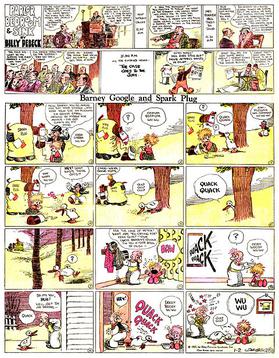
The Sunday comics or Sunday strip is the comic strip section carried in most Western newspapers. Compared to weekday comics, Sunday comics tend to be full pages and are in color. Many newspaper readers called this section the Sunday funnies, the funny papers or simply the funnies.

Grin and Bear It is a former daily comic panel created by George Lichtenstein under the pen name George Lichty. Lichty created Grin and Bear it in 1932 and it ran 83 years until 2015, making it the 10th-longest-running comic strip in American history. Frequent subjects included computers, excessive capitalism and Soviet bureaucracy. Situations in his cartoons often took place in the offices of commissars, or the showrooms of "Belchfire" dealers with enormous cars in the background. His series "Is Party Line, Comrade!" skewered Soviet bureaucrats, always wearing a five-pointed star medal with the label "Hero".

Little Iodine is an American Sunday comic strip, created by Jimmy Hatlo, which was syndicated by King Features and ran from August 15, 1943, until August 14, 1983. The strip was a spin-off of They'll Do It Every Time, an earlier Hatlo creation.

Tillie the Toiler is a newspaper comic strip created by cartoonist Russ Westover who initially worked on his concept of a flapper character in a strip he titled Rose of the Office. With a title change, it sold to King Features Syndicate which carried the strip from January 3, 1921, to March 15, 1959.
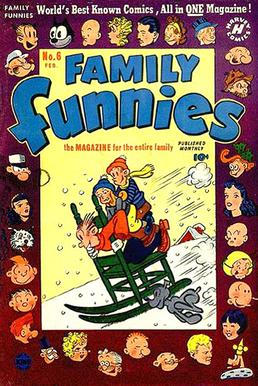
Toots and Casper is a family comic strip by Jimmy Murphy, distributed to newspapers for 38 years by King Features Syndicate, from December 17, 1918 to December 30, 1956. The strip spawned many merchandising tie-ins, including books, dolls, paper dolls, pins, bisque nodders and comic books.
Comic strip formats vary widely from publication to publication, so that the same newspaper comic strip may appear in a half-dozen different formats with different numbers of panels, different sizes of panels and different arrangement of panels.
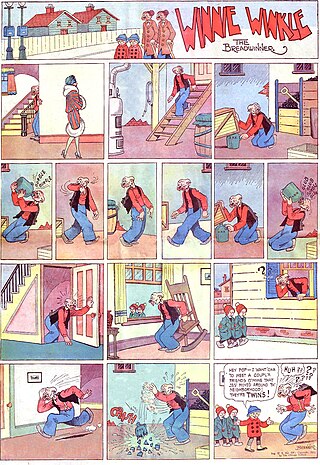
Winnie Winkle is an American comic strip published during a 76-year span (1920–1996). Ten film adaptations were also made. Its premise was conceived by Joseph Medill Patterson, but the stories and artwork were by Martin Branner, who wrote the strip for over 40 years. It was one of the first comic strips about working women. The main character was a young woman who had to support her parents and adopted brother, serving as a reflection of the changing role of women in society. It ran in more than 100 newspapers and translations of the strip's Sunday pages were made available in Europe, focusing on her little brother Perry Winkle and his gang.

Out Our Way was an American single-panel comic strip series by Canadian-American comic strip artist J. R. Williams. Distributed by Newspaper Enterprise Association, the cartoon series was noted for its depiction of American rural life and the various activities and regular routines of families in small towns. The panel introduced a cast of continuing characters, including the cowboy Curly and ranch bookkeeper Wes. Out Our Way ran from 1922 to 1977, at its peak appearing in more than 700 newspapers.
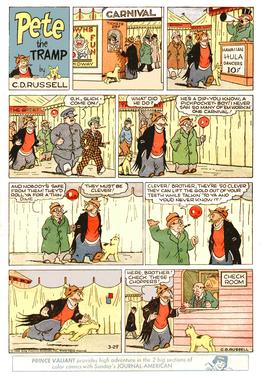
Pete the Tramp is an American comic strip by Clarence D. Russell (1895–1963) which was distributed by King Features Syndicate for more than three decades, from January 10, 1932 to December 22, 1963. Howard Eugene Wilson, in the Harvard Educational Review, described the strip's title character as "a hobo with a gentleman's instincts."
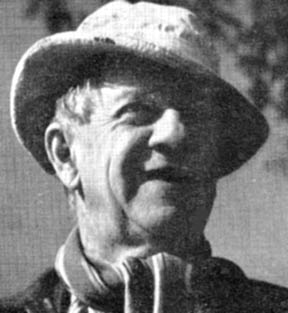
Clare Victor Dwiggins was an American cartoonist who signed his work Dwig. Dwiggins created a number of comic strips and single-panel cartoons for various American newspapers and newspaper syndicates from 1897 until 1945, including his best-known strip, the long-running School Days.
Little Joe is a 1933-1972 Western comic strip created by Ed Leffingwell and later continued by his brother Robert Leffingwell. Distributed by the Chicago Tribune Syndicate, this Sunday strip had a long run spanning four decades. It was never a daily strip.

Teena is a comic strip about a teenage girl, created by Hilda Terry. It ran from July 1, 1944, to 1963, distributed by King Features Syndicate.
Jerry on the Job is a comic strip created by cartoonist Walter Hoban, set for much of its run in a railroad station. Syndicated by William Randolph Hearst's International Feature Service, it originally ran from 1913 to 1931. The strip had a brief revival by Bob Naylor from 1946 to 1949.

Keeping Up with the Joneses was an American gag-a-day comic strip by Pop Momand that ran from March 31, 1913, to April 16, 1938. It depicts the McGinis family, Aloysius, Clarice, their daughter Julie, and their housekeeper Bella Donna, who struggle to "keep up" with the lifestyle of their neighbors, the unseen Joneses. The comic coined the well-known catchphrase "keeping up with the Joneses", referring to people's tendency to judge their own social standing according to that of their neighbors.
The New York World was one of the first newspapers to publish comic strips, starting around 1890, and contributed greatly to the development of the American comic strip. Notable strips that originated with the World included Richard F. Outcault's Hogan's Alley, Rudolph Dirks' The Captain and the Kids, Denys Wortman's Everyday Movies, Fritzi Ritz, Gus Mager's Hawkshaw the Detective, Victor Forsythe's Joe Jinks, and Robert Moore Brinkerhoff's Little Mary Mixup.
Silly Symphony is a weekly Disney comic strip that debuted on January 10, 1932, as a topper for the Mickey Mouse strip's Sunday page. The strip featured adaptations of Walt Disney's popular short film series, Silly Symphony, which released 75 cartoons from 1929 to 1939, as well as other cartoons and animated films. The comic strip outlived its parent series by six years, ending on October 7, 1945.














